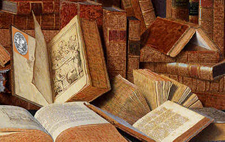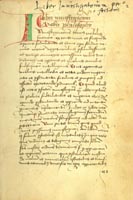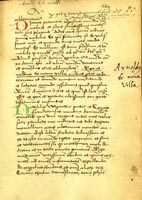in the Miskatonic University Library

...
... |
WORKS ON ALCHEMY
Artis chemicae principes
Artis auriferae
Theatrum chemicum
Bibliotheca chemica curiosa
Leiden Papyrus
Stockholm Papyrus
Compositiones Lucenses (8th
century)
Mappae Clavicula (9th + 12th
century)
Collection des anciens alchimistes
grecs
Hermes Trimegistus
Much has been attributed
to both the Egyptian god Thoth who was embraced by the Greeks as Hermes
Thrice Great (Hermes Trimegistus) or the writer who created alchemical
and philosophical works under that pseudonym. These works often bridged
into the magical. For more about Hermes Trimegistus and links ot
works attributed to him go to his page HERE.
...
...
|
PRE
CHRISTIAN
Democraticus (who may be
Bolos of Mendes (fl. 1st century B.C.)
Phisika kai mystika
Aristotle (384-322)
Claudius Ptolemy (c 150 A.D.)
Tabrir Al Magesti (Almagest)
...
...
|
EARLY
CENTURIES OF CHRISTIAN ERA
To Leucippus Book V.
Chemistry of Moses
Work of the Four Elements
The Eight Tombs
The System of Iamblichus
...
...
|
DARK
AGES
Zosimus of Panopolis (before
A.D. 400)
Synesius (4th century) commentary
on Demoncritus
Olympiodorus (6th century)
reconciled alchemy with Neoplatonism and the theory of the four elements.
Stephen of Alexandria (7th
century) (teacher of Morienus) declared that transmutation was a spiritual
process and set it in a Christological persepctive
"Christian philosopher" -
(7th century)
"Anonymous philosopher" -
(7th century)
Pelagius
John the Archpriest
|
ARABIAN
ALCHEMY
Callisthenes (Prince Khalid
ibn Yazid) (d. 704)
Liber trium verborum
Morienus (or Marianos) Byzantine
monk who taught Prince Khalid
Balinias (Apollonius of Tyana)
Book of Secrets of Creation
(circa 600-750) includes the Tabula smaragdina.
 Geber
(Jabir ibn Hayyan) (d. 815) Geber
(Jabir ibn Hayyan) (d. 815)
Liber misericordiae (mid ninth
century)
One Hundred Twelve (late ninth
century)
Liber de septuaginta (late ninth
century)
Book of Balances (early tenth
century)
Five Hundred Books (mid tenth
century)
Abu Bakr Muhammad ibn Zakariyya
al-Razi (865-923/924)
Liber secretorum - improved
the description and classification of mineral substances, expecially salts
of mercury and corrosive liquids.
Turba philosophorum - (The Tumult
of the Philosophers) tried to reconcile the basic principle of alchemy
with Greek philosophy and the Koran. A version of this work can be
found in the Miskatonic University
On-line Library
Muhammad ibn Umail al-Tamimi
(Senior Zenith)
Epistola
solis ad lunam crescentem
Ibn Sina (Avicenna)
Kitah al-Shifa (Book of Remedy)
- explained the formation of metals by sulfur and mercury but rejected
attempts at transmutation that re not based on reducing metals to the common
primal matter ("The artisans of alchemy should know that metallic compounds
cannot be chenged if they are not reduced to their primal matter.")
Epistola ad Hasen regem - may or may
not be authentic
De anima in arte alchemie (12th
cent Spain attrib to Ibn Sina but was certainly influenced by him.)
Ibn Juljul
al Tughra-i (eleventh century)
|
ARABIC
TEXTS HIT EUROPE
Hugh of Santalla (fl.
1119-1151) translated by Balinas
Robert of Ketene (Robert
the Englishman) translated
Morienus Feb 11, 1144
Gerard of Cromona translated
Libri de septuaginta
De aluminibus et alibus 12th
cent Arabic-Spanish text
Lumen luminum (attrib to Razi,
Michael Scott, or Aristotle (under the title Lapidary of Aristotle) a text
of Syriac origin with alchemical additions.
Alfred of Sareshel (Alfred the
Engishman) translated
Kitab al-Shifa (three
chapters concerning metals and alchemy as De mineralibus - these accompany
the translatio vetus of Aristotle's Meteorology, that is, books I-III translated
from Arabic by Gerard of Cremona and book IV (Sciant artifices alkimie)
translated from Greek by Henricus Aristippus.
Secret Book of Artephius
The 12th Century work explains
the process of creating the Philosopher's Stone in order to turn base metals
into gold. A version of this work can be found in the Miskatonic
University On-line Library.
...
...
|
13th
& 14th CENTURY
Michael Scot
Liber introductorius
Liber particularis
Ars alchemie (partly authentic)
presents general idea of four spirites (volatile substances), seven metals,
relations to the planets. Also explains the procedures for fixing mercury
and projecteing it on copper.
Brother Elias of Cortona, minister
general of the Franciscans
Richard Anglicus (perhaps
Richard of Wendover who died in 1252 or 1256)
Correctorium alchemiae
Quaestiones Nicolai Peripatetici
Lapidary of Aristotle
Albert of Saxony
Liber alchimie Hermes
Albertus Magnus
Meteora De Mineralibus
Albertus Magnus (?)
Semita recta
Alkimia minor
Roger Bacon
Opus terium
Alkimia practica
Roger Bacon (?)
Breve brevarum
Speculum secretorum
Verbum abbreviatum
Pope John XXII
Spondent quas non exhibent divitas
pauperes alchymistae (1317)
Jabir ibn Haayan
Summa perfectionis magisterii
(pseudo Geber) dated c. 1300
Petrus Bonus
Pretiosa margarita novella -
(1330)
 Arnald
of Villanova Arnald
of Villanova
Rosaritus
Ouaestiones tam essentiales
Epistola ad Bonifatium Papam
Epistola ad regem neapolitanum
Tractus parabolicus
John Dastin
Desiderabile desiderium
Verbum abbreviatum
Epistola ad papam Joannem XXII
Walter of Odington
Icocedron
Philips Elephant
Philosophia (enclyclopedia)
John of Pupescicca
De consideratione quinte essentiae
(1351-1352) - systemized the technical research on the distillation of
alchohol that had been going of for two centuries, associating alcohol
with the Aristotelian fifth essence by giving it the incorruptible qualities
of the elixir.
Liber lucis - He derived philosophical
sulfur frm the quintessesnce if Roman vitriol (iron sulfate), and he also
proudced calomel and corrosive sublimate.
De multiplicatione (formerly
attrib to Thomas Aquinas)
Lull
Ars magna - disignation of real
objects by letters of the alphabet, wheels, diagrams, and so forth
Testamentum - autobiography
by followers
Codicillus - by followers
Lapidarius - by followers
Leonard of Maurperg
Notebook of formulas
(1394)
Thomas Aquinas (?)
-
Aurora consurgens (late 14th century)
...
|
15th
CENTURY
Christopher of Paris
Elucidarius
(1470's)
Ulmannus
Dreyfaltigkeit
(early 15th century)
Joseph Gikatilla.
Joseph Gikkatilla (1248
- c. 1325) was a Spanish cabbalist whose works included Ginas
Egoz (pub 1615 on Gematria) as well as Sefer haMeshalim (a
cabbalistic view of ethics) as well as the Shaarei Orah and
Shaarei Tzedek (both on the 10 divine emanations forming the
Tree of Life - the sefiros). --
Mark Daniels <markwigoderdaniels@yahoo.co.uk>
.
|
16th
CENTURY
Johannes Pistorius.
- CABBALISTIC TEXTS.
- 1587. Basle. The very
scarce large folio of all the major renaissance texts linking
Jewish mysticism and Christianity. Contemporary vellum binding.
WORKS OF MOSES CORDEVERO.
This is a fifteenth century
manuscript, attractively bound in red morocco, written on wax
paper.
Moses Cordovero
(1522-70) was actually a Cabbalist. He lived in Safed in North
Palestine and was a famous populariser of Kabbala who lived
just before the Ari (Isaac Luria). His works included Pardes
Rimmonim (the orchard of Pomegranates) and Tomer Devorah (the
Palm Tree of Deborah) as well as commentaries on parts of
the Zohar.
-- Mark Daniels <markwigoderdaniels@yahoo.co.uk>
ZOHAR.
-
1558. Large folio. A complete
system of cabbalistic theology.
.
|
17th
CENTURY
Heinrich Khunrath.
-
AMPHITHEATRUM SAPIENTIAE ETERNAE.
-
1608. The very rare Magdeburg edition,
which is justly referred to as one of the seminal alchemical works. The
plates with which it is illustrated are remarkable both for their subject
matter and for their execution. This is a superb copy in contemporary vellum.
-
Guilliame Postel.
-
CLAVIS.
-
1643. Fine nineteenth century green
morocco binding. Very rare.
Knorr Von Rosenroth.
-
KABBALA DENUDATA.
-
1677. Frankfurt.
Jean d'Espagnet
-
Enchiridion physicae restitutae...
[1623]
-
or The secret work of the hermetic
philosophy: Wherein the secrets of nature and art concerning the
matter of the philosophers' stone and the manner of working are explained
in an authentic and orderly manner. The work of an anonymous author,
penes nos unda tagi. [from the 1650 edition of Arthur Dee's
'Fasciculus chemicus: or chymical collections,' translated by Elias Ashmole.]
A version of this work can be found in the Miskatonic
University On-line Library.
-
.
|
18th
CENTURY
Jean Jacques Manget.
- BIBLIOTECHA MEDICA.
- 1703. Two volumes. Red
morocco Chancery folios. These huge books are especially significant
as they are Manget's Dedication copy to Frederick the King of
Prussia. The bindings are gold-stamped with the king's royal
insignia.
Jean Jacques Manget.
- BIBLIOTECHA MEDICA
CURIOSA.
- 1702. Two volumes, folio,
contemporary calf, gilt spine. This is the first edition of
the most complete collection of alchemical texts ever published,
containing over 140 treatises. For the historian of chemistry
this is a most important and indispensable work.
SEPHER RAZIEL.
- 1701. Amsterdam. One
of the rarest of all cabbalistic works.
The Sefer Raziel is a work of Practical Kabbalah attributed
to the angel with the fiery sword who threw Adam and Eve
out of the garden of Eden. I think it appeared in medieval
Europe but am not sure. Its the only work of kabbalah I've
seen which comes with pretty pictures - mostly of amulets
designed to keep away deadly baby-milosting demons.
-- Mark Daniels <markwigoderdaniels@yahoo.co.uk>
-
FOR ALCHEMY BOOKS ON-LINE
SEE THE MISKATONIC UNIVERSITY LIBRARY "GENERAL
STACKS CARD CATALOGUE."
FOR ADDITIONAL BOOKS OF
AND ON ALCHEMY SEE THE MISKATONIC UNIVERSITY LIBRARY "ALCHEMY
STACKS CATALOGUE."
FOR LINKS TO ALCHEMY BOOKS
AND INFORMATION ON THE WORD WIDE WEB SEE THE DEPARTMENT OF COMMUNICATIONS
"LINKS SYSTEM."
...
...
|
|
\     |
| Copyright © 1997, 2002 Miskatonic
University Press / yankeeclassic.com, all rights reserved |

 Geber
(Jabir ibn Hayyan) (d. 815)
Geber
(Jabir ibn Hayyan) (d. 815)
 Arnald
of Villanova
Arnald
of Villanova